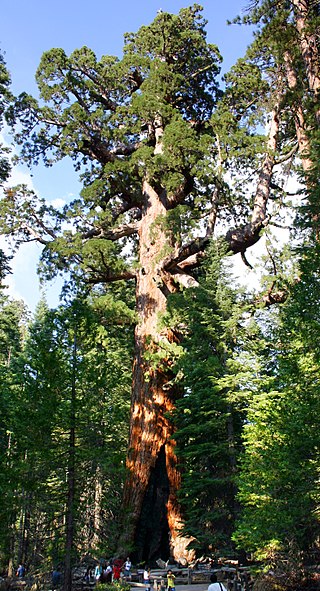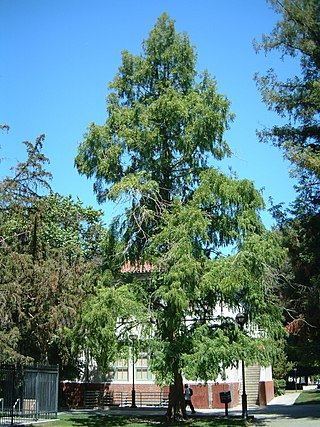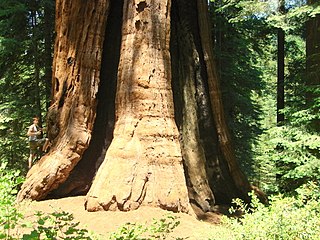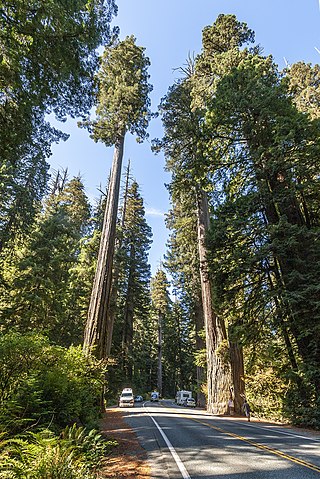
Sequoiadendron giganteum, also known as the giant sequoia, giant redwood or Sierra redwood is a coniferous tree, classified in the family Cupressaceae in the subfamily Sequoioideae. Giant sequoia specimens are the most massive trees on Earth. They are native to the groves on the western slopes of the Sierra Nevada mountain range of California but are grown around the world.

General Sherman is a giant sequoia tree located at an elevation of 2,109 m (6,919 ft) above sea level in the Giant Forest of Sequoia National Park in Tulare County, in the U.S. state of California. By volume, it is the largest known living single-stem tree on Earth.

Metasequoia glyptostroboides, the dawn redwood, is a fast-growing, endangered deciduous conifer. It is the sole living species of the genus Metasequoia, one of three genera in the subfamily Sequoioideae of the family Cupressaceae. It now survives in the wild only in wet lower slopes and montane river and stream valleys in the border region of Hubei and Hunan provinces and Chongqing municipality in south-central China, notably in Lichuan county in Hubei. Although the shortest of the redwoods, it can grow to 167 ft (51 m) in height.

Humboldt Redwoods State Park is a state park of California, United States, containing Rockefeller Forest, the world's largest remaining contiguous old-growth forest of coast redwoods. It is located 30 miles (48 km) south of Eureka, California, near Weott in southern Humboldt County, within Northern California, named after the great German nineteenth-century scientist, Alexander von Humboldt. The park was established by the Save the Redwoods League in 1921 largely from lands purchased from the Pacific Lumber Company. Beginning with the dedication of the Raynal Bolling Memorial Grove, it has grown to become the third-largest park in the California State Park system, now containing 51,651 acres (20,902 ha) through acquisitions and gifts to the state.

El Palo Alto is a coast redwood located on the banks of the San Francisquito Creek in Palo Alto, California, a city in the San Francisco Bay Area. The namesake of the city and a historical landmark, El Palo Alto is 1083–1084 years old and stands 110 feet (34 m) tall.

The Redwood National and State Parks (RNSP) are a complex of one national park, one County park and two California state parks located in the United States along the coast of northern California. The combined RNSP contain Redwood National Park, Del Norte Coast Redwoods County Park, Jedediah Smith Redwoods State Park, and Prairie Creek Redwoods State Park. The parks' 139,000 acres preserve 45 percent of all remaining old-growth coast redwood forests.

The Avenue of the Giants is a scenic highway in northern California, United States, running through Humboldt Redwoods State Park. It is named after the coastal redwoods that tower over the route. The road is a former alignment of U.S. Route 101, and continues to be maintained as a state highway as State Route 254.
The Stratosphere Giant was once considered the tallest tree in the world. It was discovered in July 2000 growing along Bull Creek in Humboldt Redwoods State Park by Chris Atkins, measuring 112.34 meters (368.6 ft) tall. The discovery was confirmed and made public in 2004, displacing the Mendocino Tree, another coast redwood, from the record books. The tree has continued to grow and measured 113.11 m (371.1 ft) in 2010 and 113.61 m (372.7 ft) in 2013. It is a specimen of the species Sequoia sempervirens, the Coast Redwood. The tree features three prominent burls on the southwestern side of its trunk and is surrounded by a large number of trees of almost equal size. In an effort to avoid damage to the tree's shallow roots by tourism, its exact location was never disclosed to the public.

Save the Redwoods League is a nonprofit organization whose mission is to protect and restore coast redwood and giant sequoia trees through the preemptive purchase of development rights of notable areas with such forests.

Montgomery Woods State Natural Reserve is a 1,323-acre state-owned park located in the Coastal Range in Mendocino County, California, United States. The Reserve occupies the headwaters of Montgomery Creek, a tributary of Big River, which flows into the Pacific Ocean at Mendocino Headlands State Park. The virgin groves of Coast Redwood in Montgomery Woods are examples of a now rare upland riparian meadow habitat; most other preserved redwood groves are on broad alluvial plains. The Reserve is accessed from a parking area along Orr Springs Road 13 miles (21 km) west of Ukiah and 15 miles (24 km) east of Comptche. A moderately steep trail from the parking area climbs uphill along Montgomery Creek about three-quarters of a mile. Once in the grove, the trail makes a meandering three miles (4.8 km) loop, with substantial use of boardwalks to protect the fragile forest floor. The reserve was initiated by a 9-acre donation from Robert T. Orr in 1945, with 765 acres donated since 1947 by the Save the Redwoods League.
Stephen C. Sillett is an American botanist specializing in old growth forest canopies. As the first scientist to enter the redwood forest canopy, he pioneered new methods for climbing, exploring, and studying tall trees. Sillett has climbed many of the world's tallest trees to study the plant and animal life residing in their crowns and is generally recognized as an authority on tall trees, especially redwoods.

The Stagg Tree, officially the Amos Alonzo Stagg Tree and formerly known as the Day Tree, is a giant sequoia in Alder Creek Grove in California's Sierra Nevada mountains. It is the fifth largest tree in the world and the tallest giant sequoia south of Lincoln in Sequoia National Park. Stagg features the second largest footprint of any living giant sequoia, measuring 109 ft (33 m) in circumference at ground level, and second only to Boole. The tree is believed to be over 3,000 years old, making it one of the oldest living giant sequoias.

Michael W. Taylor is a leading discoverer of champion and tallest trees - most notably coast redwoods. In 2006, Taylor co-discovered the tallest known tree in the world, a coast redwood now named "Hyperion". He also discovered "Helios" and "Icarus", the 2nd and 3rd tallest.

Sequoia sempervirens is the sole living species of the genus Sequoia in the cypress family Cupressaceae. Common names include coast redwood, coastal redwood and California redwood. It is an evergreen, long-lived, monoecious tree living 1,200–2,200 years or more. This species includes the tallest living trees on Earth, reaching up to 115.9 m (380.1 ft) in height and up to 8.9 m (29 ft) in diameter at breast height. These trees are also among the longest-living organisms on Earth. Before commercial logging and clearing began by the 1850s, this massive tree occurred naturally in an estimated 810,000 ha along much of coastal California and the southwestern corner of coastal Oregon within the United States.

Sequoioideae, commonly referred to as Redwoods, is a subfamily of coniferous trees within the family Cupressaceae, that range in the northern hemisphere. It includes the largest and tallest trees in the world. The trees in the subfamily are amongst the most notable trees in the world and are common ornamental trees. The subfamily was dominant during the Jurassic and Cretaceous periods.

Sequoia is a genus of redwood coniferous trees in the subfamily Sequoioideae of the family Cupressaceae. The only extant species of the genus is Sequoia sempervirens in the Northern California coastal forests ecoregion of Northern California and Southwestern Oregon in the United States. The two other genera in the subfamily Sequoioideae, Sequoiadendron and Metasequoia, are closely related to Sequoia. It includes the tallest trees, as well as the heaviest, in the world.

Bury Me in Redwood Country is a 2009 documentary film about the Redwood forest landscape. It is a meditative look at the tallest and largest trees on the planet, offering a reverential perspective that approaches the ecstatic. The film includes interviews with Redwoods experts, foresters, conservationists, native basketweavers, rangers and naturalists, including Steve Sillet and Michael Taylor. The project encapsulated a year of shooting in diverse locations in Redwood National and State Parks, Humboldt Redwoods State Park, Montgomery Woods State Reserve, Sequoia National Park, and others.




















